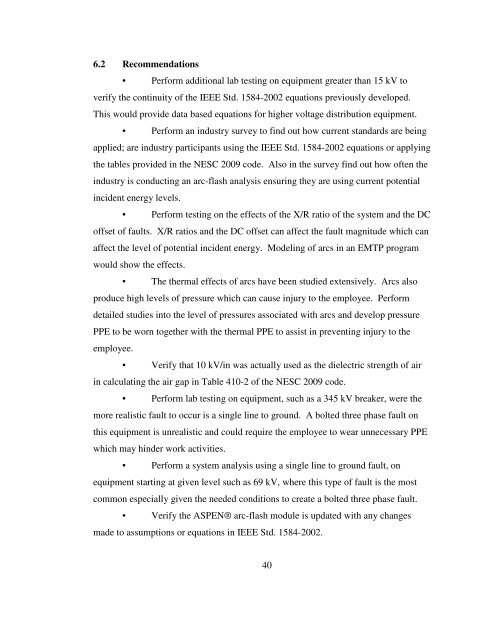arc-flash analysis of utility power systems - Michigan Technological ...
arc-flash analysis of utility power systems - Michigan Technological ...
arc-flash analysis of utility power systems - Michigan Technological ...
Create successful ePaper yourself
Turn your PDF publications into a flip-book with our unique Google optimized e-Paper software.
6.2 Recommendations<br />
• Perform additional lab testing on equipment greater than 15 kV to<br />
verify the continuity <strong>of</strong> the IEEE Std. 1584-2002 equations previously developed.<br />
This would provide data based equations for higher voltage distribution equipment.<br />
• Perform an industry survey to find out how current standards are being<br />
applied; are industry participants using the IEEE Std. 1584-2002 equations or applying<br />
the tables provided in the NESC 2009 code. Also in the survey find out how <strong>of</strong>ten the<br />
industry is conducting an <strong>arc</strong>-<strong>flash</strong> <strong>analysis</strong> ensuring they are using current potential<br />
incident energy levels.<br />
• Perform testing on the effects <strong>of</strong> the X/R ratio <strong>of</strong> the system and the DC<br />
<strong>of</strong>fset <strong>of</strong> faults. X/R ratios and the DC <strong>of</strong>fset can affect the fault magnitude which can<br />
affect the level <strong>of</strong> potential incident energy. Modeling <strong>of</strong> <strong>arc</strong>s in an EMTP program<br />
would show the effects.<br />
• The thermal effects <strong>of</strong> <strong>arc</strong>s have been studied extensively. Arcs also<br />
produce high levels <strong>of</strong> pressure which can cause injury to the employee. Perform<br />
detailed studies into the level <strong>of</strong> pressures associated with <strong>arc</strong>s and develop pressure<br />
PPE to be worn together with the thermal PPE to assist in preventing injury to the<br />
employee.<br />
• Verify that 10 kV/in was actually used as the dielectric strength <strong>of</strong> air<br />
in calculating the air gap in Table 410-2 <strong>of</strong> the NESC 2009 code.<br />
• Perform lab testing on equipment, such as a 345 kV breaker, were the<br />
more realistic fault to occur is a single line to ground. A bolted three phase fault on<br />
this equipment is unrealistic and could require the employee to wear unnecessary PPE<br />
which may hinder work activities.<br />
• Perform a system <strong>analysis</strong> using a single line to ground fault, on<br />
equipment starting at given level such as 69 kV, where this type <strong>of</strong> fault is the most<br />
common especially given the needed conditions to create a bolted three phase fault.<br />
• Verify the ASPEN® <strong>arc</strong>-<strong>flash</strong> module is updated with any changes<br />
made to assumptions or equations in IEEE Std. 1584-2002.<br />
40
















